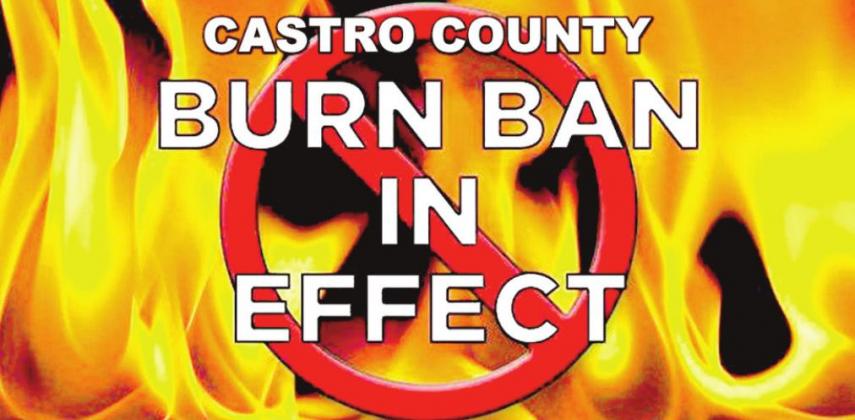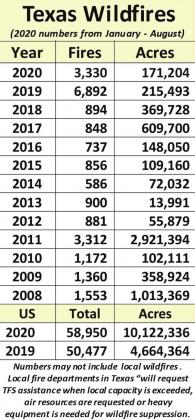Despite a minimal amount of rainfall and snow in February and March, the Castro County Commissioners Court instituted a countywide burn ban on Monday.
County Judge Carroll Gerber said the burn ban will be effect for 90 days or until commissioners determine it is safe to discontinue it.
With a lot of dry grass for fuel and current drought conditions increasing, wildfire potential is also increasing, with two accidental outbreaks the county recently.
Compliance with official burn bans reduces unsafe debris burning; but a burn ban does not have to be in effect for outdoor burning to be illegal. Negligently allowing a fire to escape onto someone else’s property is also a crime. A fire stated by burning debris or simply dropping a lit match in a dry area on one’s own property and causing a wildfire which then damages someone else’s home or property, is also considered arson, no matter how accidental.
According to NOAA, drier conditions in the region associated with Lan Nina has been associated with the development and intensification of what represents the most significant U.S. spring drought since 2013.
And with drought comes a higher incidence of wildfires.
As documented, people and their activities cause more than 90 percent of all wildfires in Texas. The largest number of human-caused wildfires is the result of careless debris burning. Other causes include sparks from welding and grinding equipment, discarded smoking materials, vehicles’ exhaust systems and arson.
Drier conditions in the Southwest U.S. associated with La Niña and the failed 2020 summer monsoon have been contributing factors to the development and intensification of what represents the most significant U.S. spring drought since 2013, which will impact approximately 74 million people.
People and their activities cause more than 90 percent of all wildfires in Texas. The largest number of human caused wildfires is a result of careless debris burning. Other causes of wildfires include sparks from welding and grinding equipment, carelessly discarded smoking materials, vehicles’ exhaust systems and arson.
Safer Debris Burning
-Check for local bans on outdoor burning.
-Keep informed of wildfire danger levels.
-Avoid burning trash, leaves and brush on dry, windy days (which is not allowed at all when a burn ban is in effect). ---Check to see if weather changes are expected. Postpone outdoor burning if shifts in wind direction, high winds or wind gusts are in the forecast.
-Before doing any burning, establish wide control lines down to bare mineral soil at least five feet wide around any burn barrels and even wider around brush piles and other piled debris to be burned. The larger the debris pile, the wider the control line needed to ensure burning materials won’t be blown or roll off the pile into vegetation outside the line.
-Burn household trash only in a burn barrel or other trash container equipped with a screen or metal grid to keep burning material contained.
-Never attempt to burn aerosol cans; heated cans will explode. Flying material may cause injuries and the explosion may scatter burning material into nearby vegetation and cause a wildfire.
-Stay with outdoor fires until they are completely out.
-Keep water and hand tools ready in case your fire should attempt to spread.
Wildfires can wreak havoc on an agricultural community. Whether the fire burns up thousands of acres of pasture or entire crop fields, the economic loss to the farmer or rancher can be devastating. Taking the time to maintain equipment and prepare work areas can mitigate the threat of a fire starting on a farm or ranch.
Maintaining Equipment
-Keep mufflers and spark arresters on agricultural equipment in proper working order.
-Watch for rocks and metal when bush hogging or mowing.
-Monitor hay baling operations closely, dry hay can ignite within the baler.
-Welding Precautions-Remove vegetation from the work area. Use a sprayer to wet down the work area prior to starting welding operations. Keep water handy. Have someone with you to spot any fires that sparks ignite.
-Avoid parking vehicles in dry grass tall enough to touch the catalytic converter on the underside of your vehicle.
Homeowner Safety
Homeowners are not powerless in their defense against wildfires. By taking a proactive approach to wildfire prevention and precautions, they can significantly increase safety and the home’s likelihood of survival during a catastrophic wildfire event.
The home and the area 0- 5’ from the furthest attached exterior point of the home; defined as a non-combustible area. Science says this is the most important zone to take immediate action on as it is the most vulnerable to embers.
- Create Defensible Space with Fire Resistant Landscaping. The idea of fire-resistant landscaping is to create a separation between fuels a fire needs to continue burning. Fuels include trees surrounding the property, plants used in landscaping and even the home itself. A healthy, well-maintained landscape is important to the survival of homes during a wildfire.
-Clean roofs and gutters of dead leaves, debris and pine needles that could catch embers. Replace or repair any loose or missing shingles or roof tiles to prevent ember penetration.
-Clean debris from exterior attic vents and install 1/8-inch metal mesh screening to reduce embers.
-Repair or replace damaged or loose window screens and any broken windows. Screen or box-in areas below patios and decks with wire mesh to prevent debris and combustible materials from accumulating.
-Move any flammable material away from wall exteriors – mulch, flammable plants, leaves and needles, firewood piles – anything that can burn. Remove anything stored underneath decks or porches.
Immediate Zone
5-30’ from the furthest exterior point of the home. Landscaping/hardscapingemploying careful landscaping or creating breaks that can help influence and decrease fire behavior.
-Clear vegetation from under large stationary propane tanks.
-Create fuel breaks with driveways, walkways/paths, patios, and decks.
-Keep lawns and native grasses mowed to a height of 4 inches.
-Remove ladder fuels (vegetation under trees) so a surface fire cannot reach the crowns. Prune trees up -to 6- 10 feet from the ground; for shorter trees do not exceed 1/3 of the overall tree height.
-Space trees to have a minimum of 18 feet between crowns with the distance increasing with the percentage of slope.
-Tree placement should be planned to ensure the mature canopy is no closer than ten feet to the edge of the structure.
-Tree and shrubs in this zone should be limited to small clusters of a few each to break up the continuity of the vegetation across the landscape.
Extended zone
-30-100 feet, out to 200 feet. Landscaping – the goal here is not to eliminate fire but to interrupt fire’s path and keep flames smaller and on the ground.
-Dispose of heavy accumulations of ground litter/debris.
-Remove dead plant and tree material.
-Remove small conifers growing between mature trees.
-Remove vegetation adjacent to storage sheds or other outbuildings within this area.
-Trees 30 to 60 feet from the home should have at least 12 feet between canopy tops.*
-Trees 60 to 100 feet from the home should have at least 6 feet between the canopy tops.*
The goal of fire-resistant landscaping is to lower the intensity of a wildfire as it approaches your home. Vegetation that encourages wildlife and enhances water or energy conservation goals can be part of a Fire wise landscape as long as defensible space is maintained.
First Responders
A quick response to a wildfire is critical for saving your home. Firefighting personnel must be able to quickly locate and safely travel to your home. Emergency responders may not be familiar with a community, so highly visible signs are important to help them find their way. People should also remember that fire trucks are larger and heavier than normal vehicles, it is essential that all access lanes are wide enough, have proper clearance and can support the weight of fire vehicles. making sure emergency personnel can quickly locate and get to a home can increase a home’s chance of survival during a wildfire.
-Street Signs with words on a contrasting color background; it should be made of reflective fire-resistant material visible from both directions. Streets should be labeled, and every home should have its own house number and be in numerical order along the street or at the end of the driveway if the home is set back from the street.
-Single lane one-way roads should have turnout spaces at regular intervals to allow emergency vehicles access and cars to pass.
-Roads and driveways must not be too steep or have sharp curves.
-Dead end streets and long driveways should have a turnaround area designed as a T or circle large enough to allow emergency equipment to turn around.


